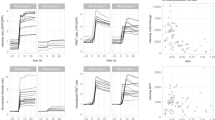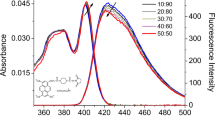Abstract
At high concentrations, certain fluorophores undergo self-quenching, i.e., fluorescence intensity decreases with increasing fluorophore concentration. Accordingly, the self-quenching properties can be used for measuring water volume changes in lipid vesicles. In cells, quantitative determination of water transport using fluorescence self-quenching has been complicated by the requirement of relatively high (mM) and often toxic loading concentrations. Here we report a simple method that uses low (μM) loading concentrations of calcein-acetoxymethyl ester (calcein-AM) to obtain intracellular concentrations of the fluorophore calcein suitable for measurement of changes in cell water volume by self-quenching. The relationship between calcein fluorescence intensity, when excited at 490 nm (its excitation maximum), and calcein concentration was investigated in vitro and in various cultured cell types. The relationship was bell-shaped, with the negative slope in the concentration range where the fluorophore undergoes fluorescence self-quenching. In cultured retinal pigment epithelial cells, calcein fluorescence and extracellular osmolarity were linearly related. A 25-mOsm hypertonic challenge corresponded to a decrease in calcein fluorescence with high signal-to-noise ratio (>15). Similar results were obtained with the fluorophore BCECF when excited at its isosbestic wavelength (436 nm). The present results demonstrate the usefulness of fluorescence self-quenching to measure rapid changes in cell water volume.
Similar content being viewed by others
REFERENCES
B. Walter (1888) Ann. Phys. (Leipzig) 34, 316–326.
B. Walter (1888) Ann. Phys. (Leipzig) 34, 502–517.
B. Walter (1888) Ann. Phys. (Leipzig) 34, 518–533.
R. F. Chen and J. R. Knutson (1988) Anal. Biochem. 172, 61–77.
D. A. Kendall and R. C. MacDonald (1983) Anal. Biochem. 134, 26–33.
P. Y. Chen, D. Pearce, and A. S. Verkman (1988) Biochemistry 27, 5713–5718.
R. Ye, L.-B. Shi, W. I. Lencer, and A. S. Verkman (1989) J. Gen. Physiol. 93, 885–902.
Y. X. Wang, L. B. Shi, and A. S. Verkman (1991) Biochemistry 30, 2888–2894.
S. Jayaraman, Y. Song, and A. S. Verkman (2001) J. Gen. Physiol. 117, 423–430.
A. S. Verkman (2000) J. Membr. Biol. 173, 73–87.
F. J. Alvarez-Leefmans, J. Altamirano, and W. E. Crowe (1995) Meth. Neurosci. 27, 361–391.
W. E. Crowe, J. Altamirano, L. Huerto, and F. J. Alvarez-Leefmans (1995) Neuroscience 69, 283–296.
J. Farinas, M. Kneen, M. Moore, and A. S. Verkman (1997) J. Gen. Physiol. 110, 283–296.
F. Wehner, H. Sauer, and R. K. Kinne (1995) J. Gen. Physiol. 105, 507–535.
F. Wehner and H. Tinel (2000) Pflugers Arch. 441, 12–24.
F. Wehner and H. Tinel (1998) J. Physiol. 503 (Pt 1), 127–142.
R. Greger, D. Heitzmann, M. J. Hug, E. K. Hoffman, and M. Bleich (1999) Pflugers Arch. 438, 165–176.
X. M. Wang, P. I. Terasaki, G.W. Rankin, Jr., D. Chia, H. P. Zhong, and S. Hardy (1993) Hum. Immunol. 37, 264–270.
S. Muallem, B.-X. Zhang, P. A. Loessberg, and R. A. Star (1992) J. Biol. Chem. 267, 17658–17664.
S. P. Srinivas and J. A. Bonanno (1997) Am. J. Physiol. 272, C1405–C1414.
Author information
Authors and Affiliations
Corresponding author
Rights and permissions
About this article
Cite this article
Hamann, S., Kiilgaard, J.F., Litman, T. et al. Measurement of Cell Volume Changes by Fluorescence Self-Quenching. Journal of Fluorescence 12, 139–145 (2002). https://doi.org/10.1023/A:1016832027325
Issue Date:
DOI: https://doi.org/10.1023/A:1016832027325




